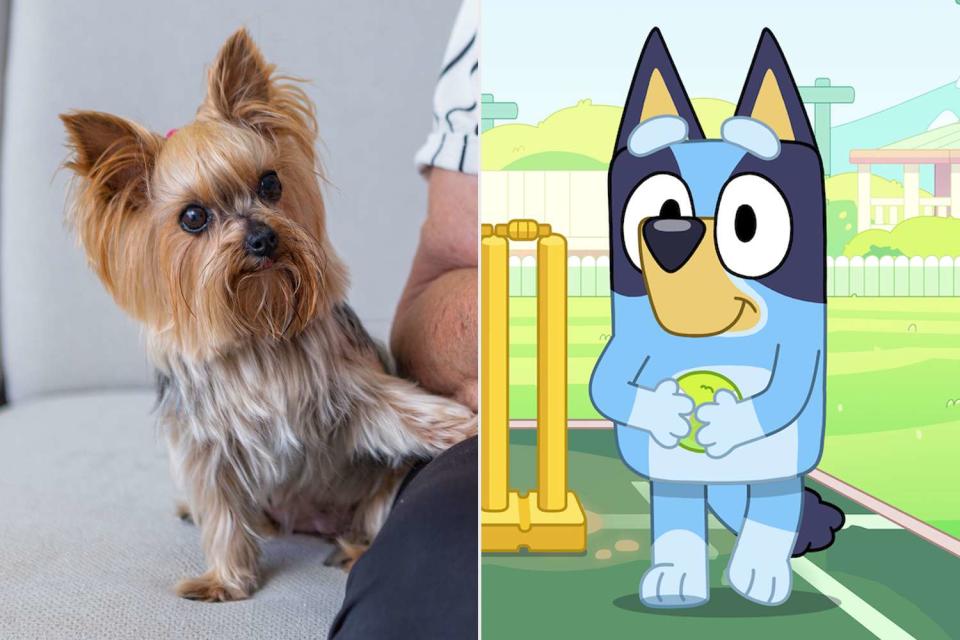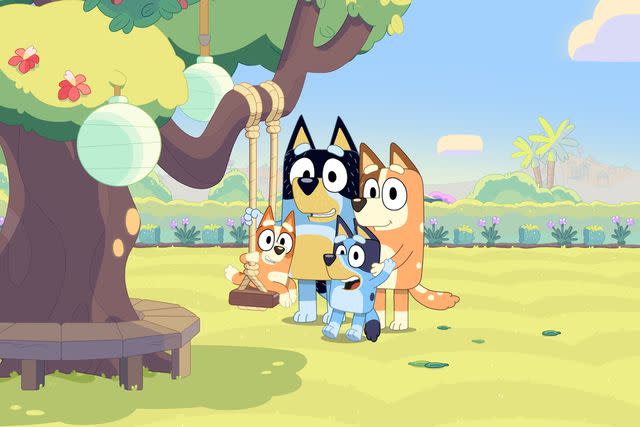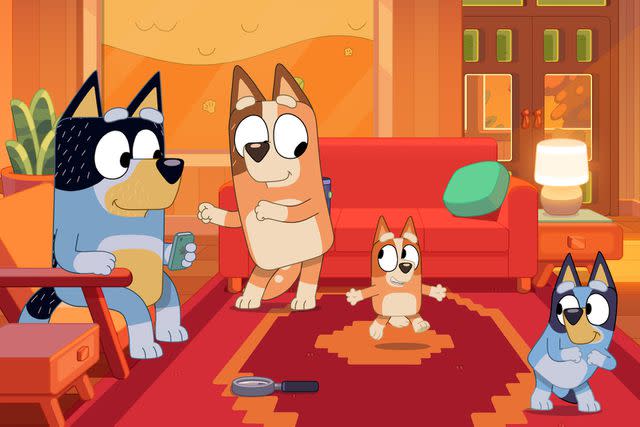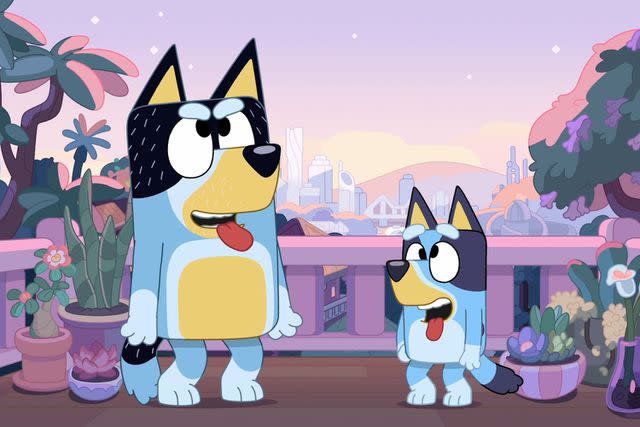Why Dogs Love Watching “Bluey”, According to an Expert
Amanda Farah, National Training & Behavior Coordinator for Best Friends Animal Society, tells PEOPLE there are many reasons why your dog loves watching 'Bluey'

Juan Algar/Getty; Ludo Studio/Disney+
People can’t get enough of the animated series Bluey, and apparently, neither can dogs.
The Australian series, which follows an animated Blue Heeler puppy throughout many journeys with her family and friends, has become a fan-favorite since it premiered in 2018.
While the primary target audience of the show is preschool-aged children, many fans have anecdotally noticed that their other babies — their dogs — are rapt at attention when the show is on.
So, why are dogs so enthralled by Bluey? Amanda Farah, National Training & Behavior Coordinator for Best Friends Animal Society, tells PEOPLE there are many different reasons why the show has become known as “dog entertainment.”
Through her position, Farah works a lot with dogs, gaining perspective on the ways they behave and how they communicate with humans. As she’s working towards her master’s in Animal Welfare & Behavior at Penn Vet, she also has been researching dogs and how they interact with video.
Read ahead as she breaks down the various reasons why dogs can’t get enough of Bluey.
Related: Bluey Will Be Back! Everything We Know About Season 4 (So Far)
It uses colors dogs can see

Ludo Studio/Disney Junior
One of the most popular theories about why dogs love Bluey is its blue-and-yellow heavy color palette. Though she says "we can't get inside a dog's brain and know ... for sure" which colors they can see, there is some evidence to suggest they see blue and yellow.
“They can discriminate blue and yellow,” Farah says. “Maybe they don't see blue as the blue we see it or yellow as the yellow we see it, but they can tell the differences between those.”
“They see contrast of other colors,” Farah adds, noting there’s been work done where dogs “can distinguish between the primary color," and another which suggests they might “see in ultraviolet," perhaps even seeing colors humans don't.
“We don't know for sure, but a lot of people sure do latch onto this theory that they can see in blue and yellow,” Farah says. “We do see some evidence that when we present them with toys or videos in those colors that they seem really drawn to them.”
It features constant movement
Another “dog element” of the show Farah points out is the use of constant movement, which she says dogs really tune into.
“We know in studies [that have been done] that lot of dogs will just tune out completely from the video if there's not movement involved,” Farah says. “When I watch Bluey, all I see is the movement. It's high-contrast movement, so the lines are sharp and crisp, which probably helps because dog's visual acuity is not as sharp as ours.”
It uses predictable patterns

Disney+
Along with constant movement, Farah notes that there is occasionally “predictable movement,” on the show “which dogs love.” She adds that dogs can typically find these patterns “very soothing.”
“There's a really interesting study that dogs learn to detect patterns in videos,” Farah explains. “So if two people are throwing a frisbee back and forth, the dog will anticipate that the frisbee is going to the recipient. So anytime that there's a repeated motion, that would be another thing that dogs would tune into. If they could predict the way that a motion is going to happen, they really like that.”
It has high-pitched sounds
As one could have guessed, the high-pitched sounds on the show — from Bluey and her friends’ voices to all the instrument noises featured on the pilot episode "Magic Xylophone" — certainly piques the interest of dogs when they’re watching.
“There's a lot of research that shows that dogs are more apt to tune in to high-pitched voices,” Farah says. As to whether it's learned or evolutionary, she says, it might be both: “A lot of us tend to talk to our dogs in those high pitches [and that communication is] usually positive."
However, "it also could be a little bit of an evolutionary tendency because prey animals squeak in high pitches when they're being hunted,” Farah says. “So it could be a little nature and nurture happening there.”
It has accents they might not recognize

Ludo Studio/Disney Junior
Another reason why dogs in the U.S. could be interested in Bluey is that the accents of the Australian voice actors may be unfamiliar to them.
Though she hasn't reviewed any exact studies on the effect of foreign-sounding accents on dogs, she notes that in her personal experience, her dogs have shown an interest in bilingual ads.
“I think it's just because they don't recognize it and it's not a cadence that they're as familiar with,” Farah explains. “I don't know if they're not picking out words that they would normally pick out or something like that, but it definitely could play a part in that dogs are drawn to novelty. Sometimes they want to investigate the novel things.”
It keeps their attention for a short amount of time
Dogs have a short attention span, so Bluey’s kid-friendly seven-minute-long episodes may be the right length for Fido as well.
“When we're doing training with [dogs], I'm typically recommending that people's training sessions [are] not more than a couple minutes,” Farah says.
“We know that dogs seem to forget things that have happened if it's [been] more than three or four minutes,” Farah continues — and the constant motion of Bluey's animation may grab them a bit longer than that.
It features dogs
Perhaps one of the most obvious reasons dogs love watching Bluey is that ... it's all about dogs! "There is research that says that dogs seem to discriminate dogs on video," Farah says. "They recognize dog shapes, which is probably not surprising."
Even though the show features cartoon dogs, Farah says they can still recognize the shapes. "[Dogs] often mistake silhouettes of dogs for real dogs," Farah notes. "The way that Bluey is drawn, it's a silhouette of a dog. The stand-up ears are really easy to distinguish."
For more People news, make sure to sign up for our newsletter!
Read the original article on People.


